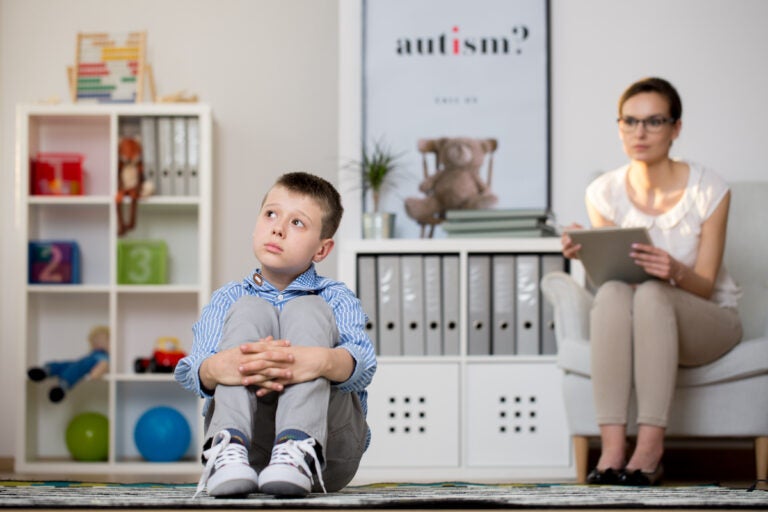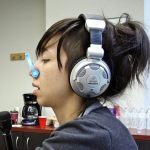Understanding PDA — when tantrums and school avoidance have deeper roots
Extreme tantrums related to any demands define PDA, but experts say it’s not about demands, it’s about anxiety.
Listen 15:03
Psychologist is looking at a child with autism spectrum disorder. (Bigstock/Kasia Bialasiewicz)
This story is from The Pulse, a weekly health and science podcast.
Find it on Apple Podcasts, Spotify, or wherever you get your podcasts.
Stella, 4, is smart, funny and has a lot of energy. Her verbal skills and cognition are advanced for her age, but Stella has struggled at every single school she’s ever attended.
Stella was diagnosed with autism when she was 2 years old, and ever since then, her mother, Lin (they asked that we not use their real names to protect their privacy) has tried to find the right educational setting for Stella.
First daycares, then preschools. Lin always asked if they could accommodate kids on the autism spectrum before enrolling Stella, and she was told they could. But it never seemed to work out.
Stella disliked structured group activities — she had trouble following rules, and needed a lot of autonomy. But beyond that, school had a profound effect on her well-being.
It all just seemed to exhaust her.
“We started to see a lot of after-school meltdowns,” said Lin. Then things got worse. Stella started to have frequent bladder control accidents, even though she had been potty-trained since she was 2 years old. She refused to eat, started biting her fingernails, and screamed and cried when they arrived at school.
“She saw the school door, and she was crying, ‘Please take me home. Don’t send me. I can’t go. Please mommy don’t go. Don’t send me in.’” Stella started having panic attacks and pervasive anxiety that extended beyond school. When nothing seemed to work, Lin became desperate to find answers — to find out what was going on with her daughter and how to help her. This is how she stumbled upon a little-known condition called PDA.
What is PDA? Understanding a challenging diagnosis
PDA stands for Pathological Demand Avoidance.
“Basically, demand avoidance is a profile where children find the demands of everyday life provoke intense anxiety, and they respond to that anxiety by trying to avoid the demands,” said clinical psychologist Naomi Fisher.
Fisher specializes in autism and alternative approaches to education, and is regarded as a leading expert on PDA. Researchers in the U.K. have proposed it as a subtype of autism, but it hasn’t yet been officially recognized in the U.S.
Demands can be anything from, “It’s time to go, put on your shoes,” to, “Eat your dinner,” to even the demands of their own bodies, like being hungry or having to go to the bathroom. The result can look more like passive avoidance, or a full-scale meltdown.
Young kids have meltdowns all the time, so telling the difference between a typical tantrum and PDA can be tricky.
Subscribe to The Pulse
“I think it’s about severity, and with meltdowns, it’s often triggered by something which is a kind of accumulation of lots of things going wrong,” Fisher said.
For instance, a child comes home after a long, hard day at school, and the parent asks, “How was your day?”
“And the child just completely collapses and has a meltdown,” Fisher said. “The thing is, the parent put on that one little extra demand at that point; just that question which required a response was enough to tip that child over the top.”
Children with PDA often get labeled as spoiled or defiant. But, Fisher says, with demand avoidance, the big, over-the-top reactions and meltdowns are really about anxiety.
“It’s not just about not wanting to do things that you’re told to do, but it’s about finding demands really anxiety-provoking,” she said. “And those can be even things that you might want to do yourself. So sometimes I’ll talk to teenagers who are like, ‘I’d really love to learn to play the guitar and I was given a guitar for my birthday, and the demand of it just feels too much. It provokes this huge anxiety and I can’t do it.’”
Some experts argue that kids with PDA have a hyper-sensitive nervous system that goes into a state of “fight, flight or freeze” at the drop of a hat. And it’s often the worst at school, because school is a setting that’s full of demands.
Dealing with PDA at home
The more Lin read about PDA, the more she became convinced that it described her daughter perfectly. And she worried that her daughter’s anxiety had reached the point of school trauma and burnout — dangers that she’d been reading about online. So she, her husband, and Stella’s team of therapists decided to adopt a strategy known as the “low-demand or low arousal approach,” whereby she would reduce the demands placed on Stella.
It was a big shift for Lin — both in how she parented, and in how she viewed her daughter.
“It helped me radically accept my kid,” Lin said. “To understand, yes — this is a nervous system disability. She’s not being a bad kid. She needs accommodations. She needs help.”
Fisher says it’s important to note that low-demand parenting doesn’t equal no-demand parenting.
“The aim with low-demand parenting is not that you’re going to spend your entire life lowering demands for your child,” Fisher said. “It’s that you lower the demands for your child so that their anxiety is low enough so that they can learn. And so that they can start ultimately to learn how they work, how their own internal system works.”
Ideally, as teenagers, they start to figure out what exactly provokes anxiety in them, and strategies for dealing with it.
For Lin, figuring out a way to parent her daughter has been a lonely journey.
“We feel really isolated, and our kid is also in such stress,” she said. “We’re basically in survival mode, just trying to pass every day. That was really hard.”
When she asked for help and support at the different schools Stella attended, Lin found, there really weren’t any resources that were able to help.
But Lin and Stella aren’t alone in this — especially when you look at the school experiences of other autistic and PDA kids.
“I think [it’s] incredibly common,” said Zach Morris, an educational consultant and family support specialist in Montana, who specializes in autistic and PDA kids. “I think it’s an overwhelming majority of families that find themselves in this predicament.”
Morris says the vast majority of PDA kids experience similar struggles with school, adding that a lot of them are in a near-constant state of anxiety and fear, but aren’t getting the help or
accommodations that they need. And that can lead to problems — especially when they’re forced to attend school every day, regardless of their distress levels.
“I see sort of the dangers being driven and stuck in fear and anxiety and self-deprecation and shame,” Morris said. “What I really see is deep shame cycles. ‘What’s wrong with me? Why can’t I do this?’”
In the end, a lot of parents of PDA kids — 70% — end up doing the same thing: homeschooling.
Which, after a lot of heartache, is what Lin ultimately decided to do. Right now, her daughter has a deep aversion to school, or anything that looks like a school, but she still loves to learn. And Lin wants to keep it that way. So far, keeping Stella home has worked out well. The signs of panic, the fear, the anxiety — all of it has gotten a lot better.
WHYY is your source for fact-based, in-depth journalism and information. As a nonprofit organization, we rely on financial support from readers like you. Please give today.







